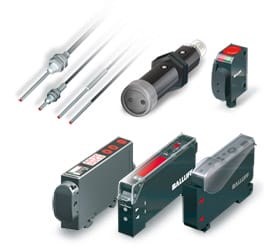
Designed for remote sensing, fiber optic cables and amplifiers offer reliable operation in difficult areas characterized by high temperatures, aggressive chemicals, or limited mounting space. Fiber optic cables conduct the light to and from the emitter/receiver amplifier, allowing the amplifier to be installed remotely, out of harm’s way.
There are two basic types of fiber optic cables: diffuse (bifurcated) and thru-beam. Diffuse types have two separate control ends merged into one sensing tip. One-half of the fiber bundle transmits light while the other returns it. Objects are detected when the emitted light is reflected from a target to the receiver. Using a reflector increases the sensing distance but creates a dead zone in front of the sensing tip.
Thru-beam fiber optic setups rely on two individual fiber optic cables facing each other. A beam is established between the two fiber cables and objects are detected when they pass through, breaking the beam from the emitter to the receiver.
Applications
- Small parts detection
- Suitable for installation in space restricted areas
- Level detection through clear tubes
- Precise positioning of parts
- Assembly
- Robotics
